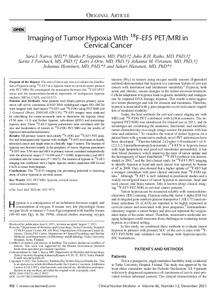Imaging of Tumor Hypoxia With F-18-EF5 PET/MRI in Cervical Cancer
Narva Sara I.; Seppänen Marko P.; Raiko Juho R. H.; Forsback Sarita J.; Orte Katri J.; Virtanen Johanna M.; Hynninen Johanna; Hietanen Sakari
https://urn.fi/URN:NBN:fi-fe2021120859672
Tiivistelmä
Purpose of the Report
The aim of this study was to evaluate the distribution of hypoxia using 18F-EF5 as a hypoxia tracer in cervical cancer patients with PET/MRI. We investigated the association between this 18F-EF5-PET tracer and the immunohistochemical expression of endogenous hypoxia markers: HIF1α, CAIX, and GLUT1.
Patients and Methods
Nine patients with biopsy-proven primary squamous cell cervix carcinoma (FIGO 2018 radiological stages IB1–IIIC2r) were imaged with dual tracers 18F-EF5 and 18F-FDG using PET/MRI (Int J Gynaecol Obstet. 2019;145:129–135). 18F-EF5 images were analyzed by calculating the tumor-to-muscle ratio to determine the hypoxic tissue (T/M ratio >1.5) and further hypoxic subvolume (HSV) and percentage hypoxic area. These 18F-EF5 hypoxic parameters were correlated with the size and localization of tumors in 18F-FDG PET/MRI and the results of hypoxia immunohistochemistry.
Results
All primary tumors were clearly 18F-FDG and 18F-EF5 PET positive and heterogeneously hypoxic with multiple 18F-EF5–avid areas in locally advanced cancer and single areas in clinically stage I tumors. The location of hypoxia was detected mainly in the periphery of tumor. Hypoxia parameters 18F-EF5 max T/M ratio and HSV in primary tumors correlated independently with the advanced stage (P = 0.036 and P = 0.040, respectively), and HSV correlated with the tumor size (P = 0.027). The location of hypoxia in 18F-EF5 imaging was confirmed with a higher hypoxic marker expression HIF1α and CAIX in tumor fresh biopsies.
Conclusions
The 18F-EF5 imaging has promising potential in detecting areas of tumor hypoxia in cervical cancer.
Kokoelmat
- Rinnakkaistallenteet [27094]
